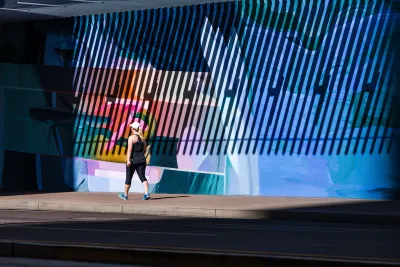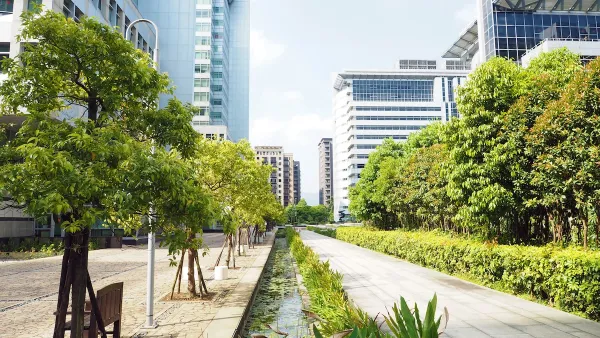Coatings that reflect heat can make the air feel warmer for people standing on and around these surfaces.

New research from Arizona State University delves into the complicated impacts of cool pavement treatments, which can reduce surface temperatures in concrete-heavy urban areas but can also increase the “thermal stress” felt by a person standing on these heat-reflective surfaces and are thus not appropriate for all areas.
Writing in Smart Cities Dive, Ysabelle Kempe explains, “Cool pavement technology is most effective on large parking lots that lack shade or in car-centric cities with hot climates, low cloud cover and wide residential streets, the researchers say. It’s not effective in high-rise downtown areas and shouldn’t be used in areas with high pedestrian traffic like playgrounds, plazas or parks, they add.”
In essence, the treatments have a bigger effect on the surface they’re applied to than on the ambient temperature for people walking on them. “Experts say these types of results indicate cool pavement is not a solution to rising heat-related illness and death tolls. Indeed, the researchers in Phoenix say that installing cool pavement in areas with high pedestrian traffic could be considered a ‘maladaptation’ in regards to the experience of pedestrians,” inadvertently putting people at higher risk for heat-related illnesses.
The study suggests that cities’ heat mitigation strategies should focus more on trees and other ways to create shade.
FULL STORY: Phoenix cool pavement study shows technology tradeoffs

National Parks Layoffs Will Cause Communities to Lose Billions
Thousands of essential park workers were laid off this week, just before the busy spring break season.

Retro-silient?: America’s First “Eco-burb,” The Woodlands Turns 50
A master-planned community north of Houston offers lessons on green infrastructure and resilient design, but falls short of its founder’s lofty affordability and walkability goals.

Delivering for America Plan Will Downgrade Mail Service in at Least 49.5 Percent of Zip Codes
Republican and Democrat lawmakers criticize the plan for its disproportionate negative impact on rural communities.

Test News Post 1
This is a summary

Test News Headline 46
Test for the image on the front page.

Balancing Bombs and Butterflies: How the National Guard Protects a Rare Species
The National Guard at Fort Indiantown Gap uses GIS technology and land management strategies to balance military training with conservation efforts, ensuring the survival of the rare eastern regal fritillary butterfly.
Urban Design for Planners 1: Software Tools
This six-course series explores essential urban design concepts using open source software and equips planners with the tools they need to participate fully in the urban design process.
Planning for Universal Design
Learn the tools for implementing Universal Design in planning regulations.
EMC Planning Group, Inc.
Planetizen
Planetizen
Mpact (formerly Rail~Volution)
Great Falls Development Authority, Inc.
HUDs Office of Policy Development and Research
NYU Wagner Graduate School of Public Service





























